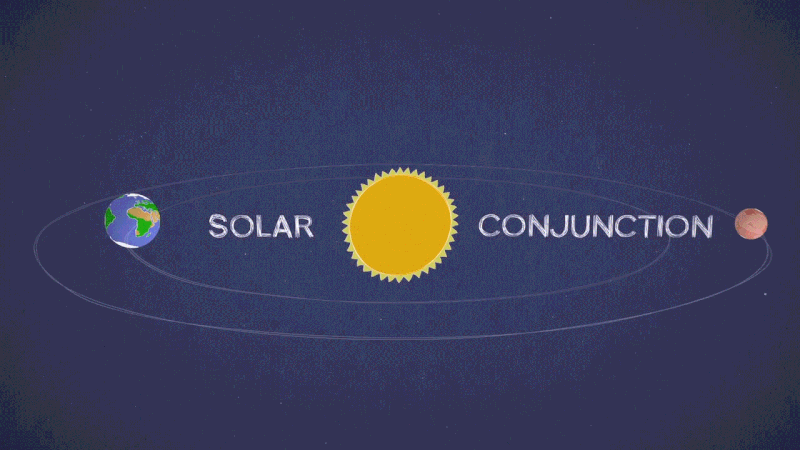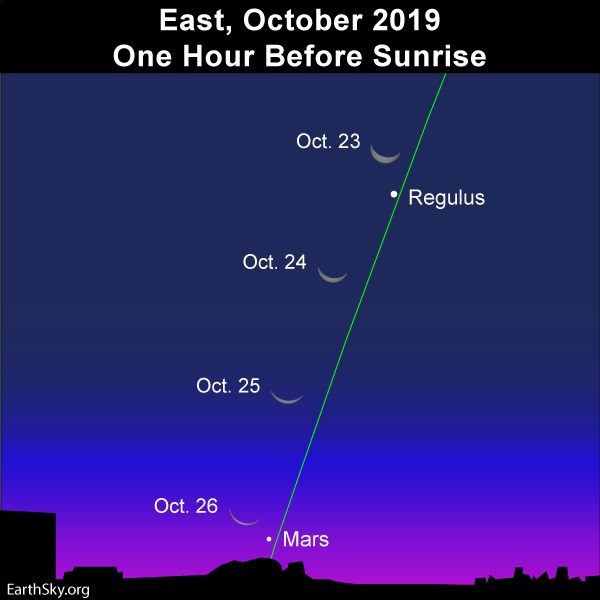It happens about every two years. Moving in its smaller and faster orbit around the sun, Earth “turns the corner” ahead of Mars, placing the sun between us and the red planet. At these times, Mars is gone from our night sky, traveling across the sky with the sun during the day. Astronomers call this event a conjunction; Mars will be precisely in conjunction with the sun on September 2, 2019. For space engineers, though – those responsible for Earth’s fleet of active spacecraft now orbiting or roving on Mars – having the sun between us and Mars poses a potential risk. The risk is that – due to radio interference from hot, ionized gas in the sun’s corona, or outer atmosphere – a command from Earth might become garbled, causing a spacecraft to respond in an unexpected way. To be safe, NASA engineers say they’ll hold off sending commands to Mars spacecraft from August 28 to September 7, 2019. Roy Gladden, manager of the Mars Relay Network at NASA’s Jet Propulsion Laboratory in Pasadena, California, said:
It’s that time again. Our engineers have been preparing our spacecraft for conjunction for months. They’ll still be collecting science data at Mars, and some will attempt to send that data home. But we won’t be commanding the spacecraft out of concern that they could act on a corrupted command.
So the chatter that typically goes on between Earth and Mars will be silent in the coming weeks. What will NASA’s Mars craft do in the meantime?

A statement from NASA on August 23 explained:
Although some instruments aboard spacecraft – especially cameras that generate large amounts of data – will be inactive, all of NASA’s Mars spacecraft will continue their science; they’ll just have much simpler ‘to-do’ lists than they normally would carry out.
On the surface of Mars, the Curiosity rover will stop driving, while the InSight lander won’t move its robotic arm. Above Mars, both the Odyssey orbiter and the Mars Reconnaissance Orbiter will continue collecting data from Curiosity and InSight for return to Earth. However, only Odyssey will attempt to relay that data to Earth before conjunction ends. Meantime, another orbiter, MAVEN, will continue to collect its own science data but won’t support any relay operations during this time.
All of this means that there will be a temporary pause in the stream of raw images available from Curiosity, InSight and the other Mars missions.
Mars solar conjunction impacts operations of all spacecraft currently at Mars, not just NASA’s.
Once conjunction is over, NASA said, the spacecraft will beam the data they’ve collected to NASA’s Deep Space Network, a system of massive Earth-based radio antennas managed by the Jet Propulsion Laboratory. Engineers will spend about a week downloading the information before normal spacecraft operations resume. NASA also said:
If the teams monitoring these missions determine any of the collected science data are corrupted, they can usually have that data retransmitted after the moratorium ends on September 7.
As for the engineers themselves, they intend to use this time to catch up on necessary tasks, or even take some R&R.
And when will Mars return to Earth’s night sky? It’ll take longer for Mars to become visible in our night sky than it will for signals to and from Mars to resume. You can expect to see Mars again in October. In fact, late October may feature your first decent chance to catch this world in the east before sunrise, as shown on the chart below.

For more about NASA’s Mars Exploration Program, visit:
Want to see planets? Visit EarthSky’s monthly planet guide
Bottom line: Between August 28 and September 7, 2019, there will be a radio silence imposed between Earth and Mars. The reason is that the sun is between us and Mars now. Hot, ionized gases in the sun’s corona can corrupt radio signals, leading to unexpected results from commands sent to our spacecraft from Earth.











